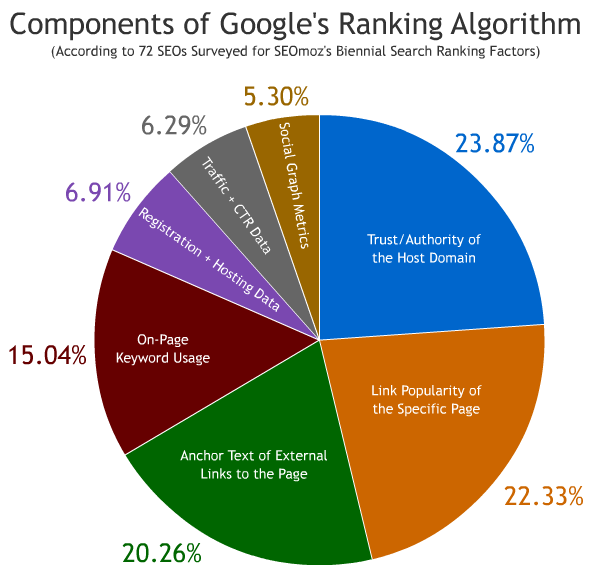Having a high Page Rank for your site is good, but it’s not the only factor that determines your website’s relevance in terms of search results.
What is the real end goal to having a successful site on the web? To make more money, attract more visitors and readers right?! It is impossible to know and understand every search metric and algorithm being used, since Google uses more than 200 to determine search engine result pages (SERP). In the post panda era, creating your sites content with the reader’s experience in mind is a good place to start. Google Analytics is a helpful tool to use for measuring your site’s web traffic.
The more you think about the visitor experience when creating robust content and adding pictures the better off you will be. These metrics are important to look at for the user experience. In the post panda seo environment, the amount of time users stay on your website will play a role in how Google views your site. Seomoz did a whiteboard friday a few weeks ago about post panda and your site, they went into a lot detail about this subject.
“Finally, you are going to be optimizing around user and usage metrics. Things like, when people come to your site, generally speaking compared to other sites in your niche or ranking for your keywords, do they spend a good amount of time on your site, or do they go away immediately? Do they spend a good amount of time? Are they bouncing or are they browsing? If you have a good browse rate, people are browsing 2, 3, 4 pages on average on a content site, that’s decent. That’s pretty good. If they’re browsing 1.5 pages on some sites, like maybe specific kinds of news sites, that might actually be pretty good. That might be better than average. But if they are browsing like 1.001 pages, like virtually no one clicks on a second page, that might be weird. That might hurt you. Your click-through rate from the search results. When people see your title and your snippet and your domain name, and they go, “Ew, I don’t know if I want to get myself involved in that. They’ve got like three hyphens in their domain name, and it looks totally spammy. I’m not going to get involved.” Then that click-through rate is probably going to suffer and so are your rankings.” – Seomoz Rand Fishkin
Below are a few definitions from Google web master’s latest blogs about this subject:
- Conversion rate
- Bounce rate
- Clickthrough rate (CTR)
Conversion rate
A “conversion” is when a visitor does what you want them to do on your website. A conversion might be completing a purchase, signing up for a mailing list, or downloading a white paper. Your conversion rate is the percentage of visitors to your site who convert (perform a conversion). This is a perfect example of a metric that, unlike PageRank, is directly tied to your business goals. When users convert they’re doing something that directly benefits your organization in a measurable way! Whereas your PageRank is both difficult to measure accurately, and can go up or down without having any direct effect on your business.
Bounce rate
A “bounce” is when someone comes to your website and then leaves without visiting any other pages on your site. Your bounce rate is the percentage of visits to your site where the visitor bounces. A high bounce rate may indicate that users don’t find your site compelling, because they come, take a look, and leave directly. Looking at the bounce rates of different pages across your site can help you identify content that’s underperforming and point you to areas of your site that may need work. After all, it doesn’t matter how well your site ranks if most searchers are bouncing off of it as soon as they visit.
Clickthrough rate (CTR)
In the context of organic search results, your clickthrough rate is how often people click on your site out of all the times your site gets shown in search results. A low CTR means that, no matter how well your site is ranking, users aren’t clicking through to it. This may indicate that they don’t think your site will meet their needs, or that some other site looks better. One way to improve your CTR is to look at your site’s titles and snippets in our search results: are they compelling? Do they accurately represent the content of each URL? Do they give searchers a reason to click on them? Here’s some advice for improving your snippets; the HTML suggestions section of Webmaster Tools can also point you to pages that may need help. Again, remember that it doesn’t matter how well your site ranks if searchers don’t want to click on.

Conclusions about Page Rank and Search Engine Page Results factors to keep in mind.
PageRank is just one of many ranking factors used to determine ranking in search results. Try to improve your website’s speed or loading page time. Studies show faster sites create a happier user experience. When a site responds slowly, visitors get impatience and spend less time there. Sometimes using flash and image sliders can slow down your website. These are just a few of the 200 metrics Google uses. Of course relevance of a page is still the biggest factor in search results. The anchor text of a link is usually far more important than whether it’s on a high PageRank page. And having lots of high quality backlinks is also important in search results. If you really want to know what are the most important, relevant pages to get links from, forget PageRank. Think search rank. Search for the words you’d like to rank for. See what pages come up tops in Google. Those are the most important and relevant pages you want to seek links from. That’s because Google is explicitly telling you that on the topic you searched for, these are the best. Feel free to visit our other blogs for more useful information.






9 Responses
You touched on 3 of the top factors that makes a website owner a winner – the ultimate reasons for ranking high on the search engines are definitely to get most browsers click through, stay long and read a couple of pages on blog and take action (to do) the call to action.
If a blog/ website is short on one or more of those, then every traffic generation and SEO effort is a waste.
Thanks for bringing these to bare.
Thanks stelsie
Recently one of my blogs page rank get down. I am not sure what is happening. Is it related to Google Panda update?
Thanks for your question. As it happens, Google just released another update last night, Panda 3.3, which they claim removes a “link evaluation signal” that they’ve been using for years, here it is, straight from Google’s Blog:
*”Link evaluation. We often use characteristics of links to help us figure out the topic of a linked page. We have changed the way in which we evaluate links; in particular, we are turning off a method of link analysis that we used for several years. We often re-architect or turn off parts of our scoring in order to keep our system maintainable, clean and understandable.” -Google
*
What we think this means is that if links with anchor text are not leading to a credible link, which I’m assuming they evaluate by how long a person stays on the page they clicked to, then they may bring down the relevancy of that link in their algorithms and lower the position or rank? This is our own speculation, of course, and should not be taken as advice. They are very secretive, for various reasons, so all we can say is make your content more informational and detailed, and use anchor text to bring people to a page that answers their questions.
In addition, on their blog, they listed about 40 changes they recently made to their search engine.
One upside to one of the changes is that they are stressing relevancy on
Google Local Places for results, so we suggest local business owners take
advantage of that as much as possible.
———- Forwarded message ———-
Thanks Vania for detailed reply actually should I care about my out bound links or need more optimization work on my blog to reflect the recent Google changes.
Hi Emma, Are you making a statement or asking me if you should change your outbound links?
It’s good to mix up the outbound links on your blog, don’t only link to your content, and share as much of your content on social networks.
Totally agree, various little hindrances can effect the ranking of your site. One must be very watchful when it comes to backlinking.
It’s really very hectic to face Google algorithm changes every time